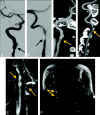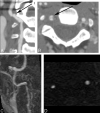Comparison of multidetector CT angiography and MR imaging of cervical artery dissection
- PMID: 18635617
- PMCID: PMC8118804
- DOI: 10.3174/ajnr.A1189
Comparison of multidetector CT angiography and MR imaging of cervical artery dissection
Abstract
Background and purpose: Conventional angiography has been historically considered the gold standard for the diagnosis of cervical artery dissection, but MR imaging/MR angiography (MRA) and CT/CT angiography (CTA) are commonly used noninvasive alternatives. The goal of this study was to compare the ability of multidetector CT/CTA and MR imaging/MRA to detect common imaging findings of dissection.
Materials and methods: Patients in the data base of our Stroke Center between 2003 and 2007 with dissections who had CT/CTA and MR imaging/MRA on initial work-up were reviewed retrospectively. Two neuroradiologists evaluated the images for associated findings of dissection, including acute ischemic stroke, luminal narrowing, vessel irregularity, wall thickening/hematoma, pseudoaneurysm, and intimal flap. The readers also subjectively rated each vessel on the basis of whether the imaging findings were more clearly displayed with CT/CTA or MR imaging/MRA or were equally apparent.
Results: Eighteen patients with 25 dissected vessels (15 internal carotid arteries [ICA] and 10 vertebral arteries [VA]) met the inclusion criteria. CT/CTA identified more intimal flaps, pseudoaneurysms, and high-grade stenoses than MR imaging/MRA. CT/CTA was preferred for diagnosis in 13 vessels (5 ICA, 8 VA), whereas MR imaging/MRA was preferred in 1 vessel (ICA). The 2 techniques were deemed equal in the remaining 11 vessels (9 ICA, 2 VA). A significant preference for CT/CTA was noted for VA dissections (P < .05), but not for ICA dissections.
Conclusion: Multidetector CT/CTA visualized more features of cervical artery dissection than MR imaging/MRA. CT/CTA was subjectively favored for vertebral dissection, whereas there was no technique preference for ICA dissection. In many cases, MR imaging/MRA provided complementary or confirmatory information, particularly given its better depiction of ischemic complications.
Figures





References
-
- Schievink WI. Spontaneous dissection of the carotid and vertebral arteries. N Engl J Med 2001;344:898–906 - PubMed
-
- Flis CM, Jager HR, Sidhu PS. Carotid and vertebral artery dissections: clinical aspects, imaging features and endovascular treatment. Eur Radiol 2007;17:820–34 - PubMed
-
- Lee VH, Brown RD Jr, Mandrekar JN, et al. Incidence and outcome of cervical artery dissection: a population-based study. Neurology 2006;67:1809–12 - PubMed
-
- Caplan LR. Dissections of brain-supplying arteries. Nat Clin Pract Neurol 2008;4:34–42 - PubMed
-
- Pelkonen O, Tikkakoski T, Leinonen S, et al. Extracranial internal carotid and vertebral artery dissections: angiographic spectrum, course and prognosis. Neuroradiology 2003;45:71–77 - PubMed
Publication types
MeSH terms
Substances
LinkOut - more resources
Full Text Sources
Medical
Miscellaneous
